Hoba Miso is a regional dish in Hida Takayama area of Japan. In this recipe, I’ll show you how to re-create this beautiful dish at home.
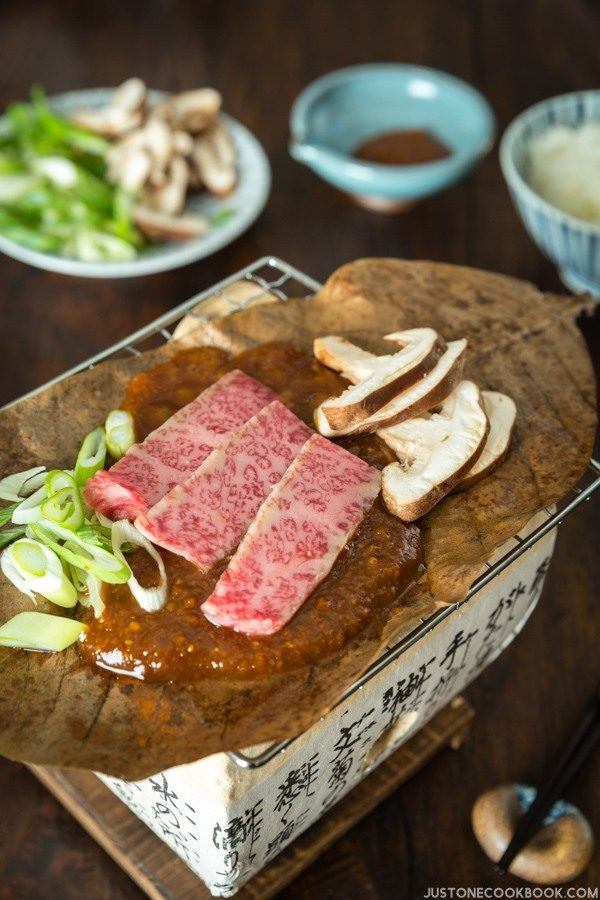
When we were in Toyama and Takayama this past summer, one of the dishes that I truly fell in love was Hoba Miso (朴葉味噌). This is a local food from Hida region in Gifu prefecture.
“Hoba” means a magnolia leaf in Japanese and the dried hoba leaf is soaked then used to cook the sweet miso mixture over fire. This is such a humble dish, yet it tastes so amazing I remembered the experience as if I just ate it yesterday.
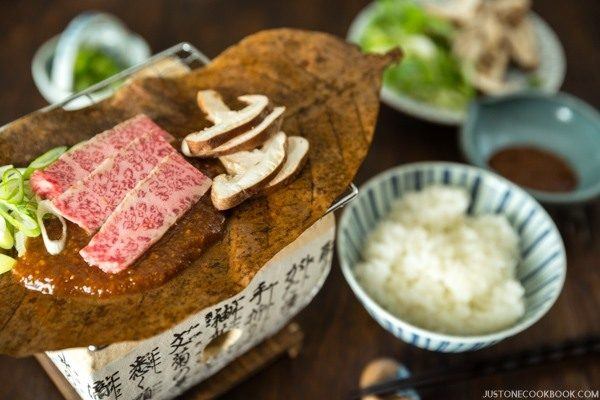
How To Enjoy Hoba Miso
The lady who served our meal at the ryokan explained that the locals in area have been enjoying Hoba Miso for many years.
In the Hida region, the winter months are harsh and snowy. Back then, there weren’t many crop and food available during the winter months and the poor farmers would eat hoba miso as “okazu” (a side dish to accompany rice) as there were not much food available.
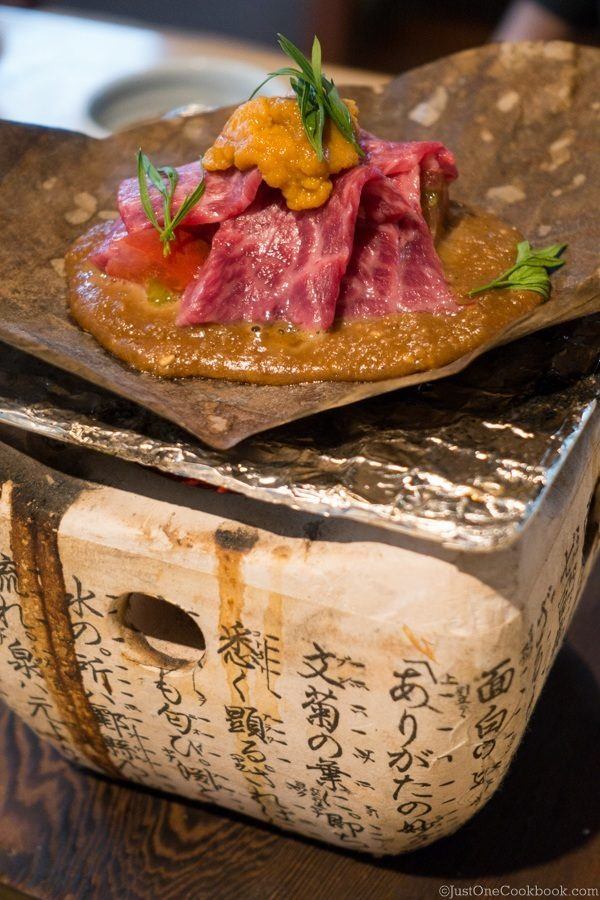
Fast forward to the present time, it’s kind of ironic that ryokans and restaurants now serve hoba miso with well-marbled and prized local Hida Beef (飛騨牛) as a signature dish for the region.
Hoba miso does not have to be cooked with beef or vegetables and can be enjoyed just by itself. When we were in Takayama, our breakfast course included plain hoba miso. It was cooked over hoba leaf without any other ingredients besides scallions.
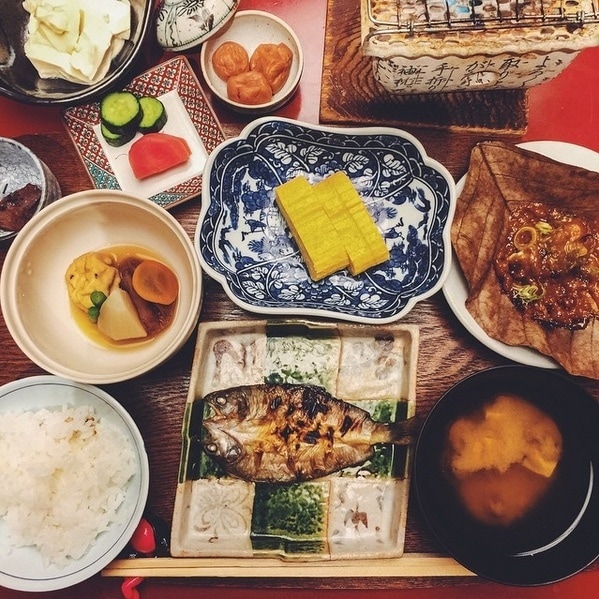
The miso would be heated until it bubbles around the edge. With chopsticks, scoop small amount of miso and enjoy it together with steamed rice.
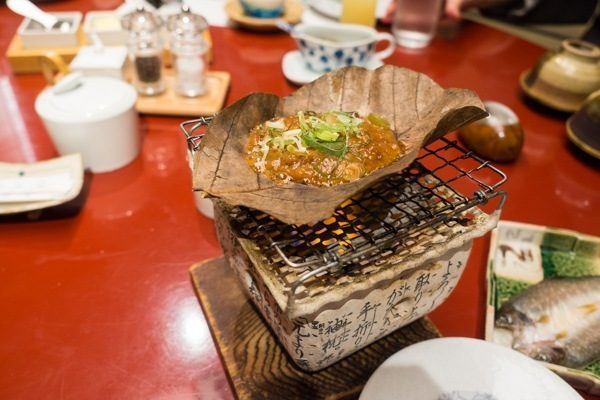
To bring back the memory of this dish we had in Takayama, we looked for Hida Beef here in the US but it wasn’t available. We decided to substitute with Miyazaki Beef from Japan, which should be as good as the Hida Beef we had in Takayama.
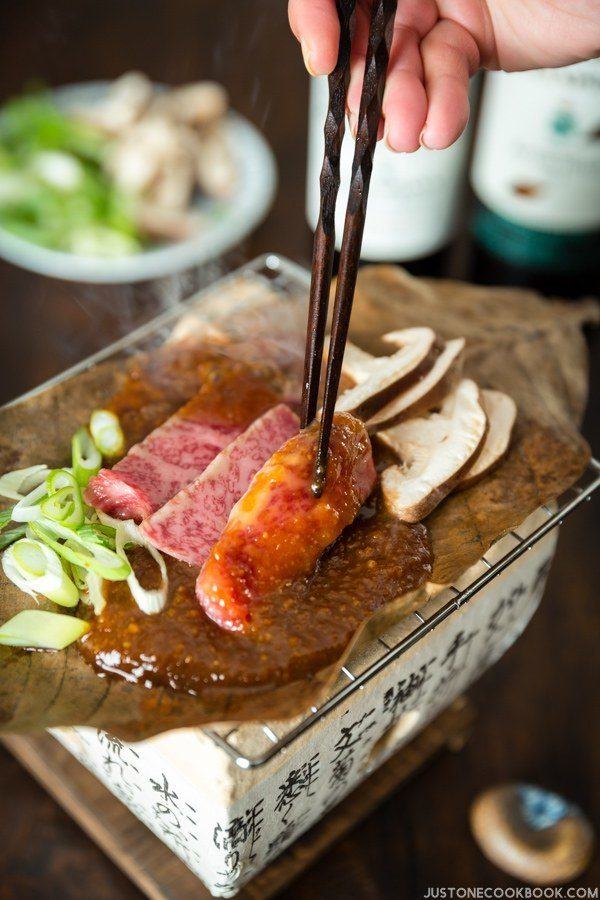
How To Prepare Hoba Miso
I understand that this recipe is almost impossible to re-create without dried hoba leaves, but I still want to introduce you to this regional Japanese recipe.
You can actually make the recipe without hoba leaves, however it will lack the fragrance and flavor infused from cooking on the leaf. In place of hoba leaf, you can use a sheet of aluminum foil instead. If you have hoba leaf but don’t have a shichirin, just use a frying pan. I have tried this method and it works great.
Simply put all the ingredients together for miso, place them on a hoba leaf or aluminum foil, and cook it over a heat element. Very simple. You can add beef, chicken, tofu, or any other protein you like, and/or vegetables and mushrooms.
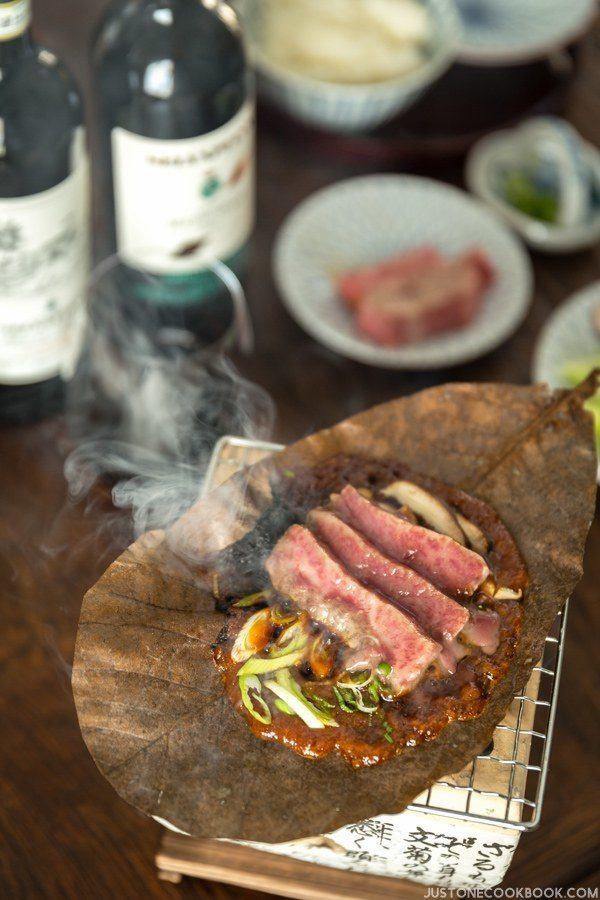
Hoba Miso with Pairing with Wine
For this delicate amazing dish, we tried it with two wines from Fattoria Selvapiana, the 2012 Chianti Rufina DOCG and 2010 Chianti Rufina Riserva “Bucerchiale” DOCG. Selvapiana is a family owned producer with over 180 years of history and currently run by the 5th generation of the family.
Both wines were delicious but very different; the Bucerchiale is their flagship wine and oh my, it was delicious! As you sniff the wine, you can already taste the strong flavor of the mature grape through the smell. Yet as you take a first sip, expecting a strong taste instead it is light, very soft and gentle and creamy on the tongue. The flavors are berries and a slight hint of spaces, with a dry finish and not overly sweet. Exceptionally elegant.
The 2012 Chianti Rufina DOCG is tastes much younger and is more fun, definitely not as refined. The initial taste is crisp and clean, with a rush of berries and a dry flavorful earthy finish. I don’t know Chianti wine as well but both of these wines are fabulous and the friends I shared them with agree as well.
Both wines are significantly less sweet than California wines, and they are great for chatting with friends or with a meal. While eating the Hoba Miso beef, the wine refreshed the palate and balanced the fat really well. I highly recommend these wines for a party or with a meal.

If you enjoy making this dish from Hida region in Japan! If you try it, don’t forget to share your picture on Instagram, Facebook, or Twitter with #JustOneCookbook. Thank you so much for reading, and till next time!
Don’t want to miss a recipe? Sign up for the FREE Just One Cookbook newsletter delivered to your inbox! And stay in touch on Facebook, Google+, Pinterest, and Instagram for all the latest updates.
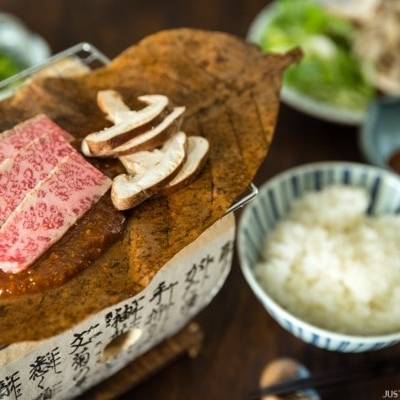
Hoba Miso with Beef
Ingredients
- 2 dried hoba leaves (magnolia leaf)
- ½ Tokyo negi (naga negi; long green onion) (or 1 scallion/green onion)
- 1 shiitake mushrooms
- 7 oz well-marbled beef steak
- 1 green onion/scallion
Instructions
- Gather all the ingredients.

- Soak the hoba leaves in the water for at least 20 minutes. This prevents the leaf from burning when you cook the leaf over open flame.

- Meanwhile, combine miso, mirin, and sugar in a small bowl and mix well.

- Slice the beef into ½ inch (1.3 cm) thickness. If you’re using well-marbled wagyu from Japan, I recommend slicing the beef when it’s still slightly frozen. Otherwise, if the beef was at room temperature, the fat easily melts when you touch it with your finger and it’s become very hard to cut.

- Cut the shiitake mushrooms, the negi, and green onion/scallion.

- Light the portable fuel (I used Sterno brand). If you don’t use a shichirin to cook, you can use a non-stick frying pan to cook instead. There is no need to oil the frying pan, simply place the leaf on top.

- When the leaves have soaked for 20 min, gently dry with paper towel and spread the miso mixture on the leaves where you will be placing the ingredients.

- Place the negi (scallions), shiitake mushrooms, and steak on the miso.

- Cook the beef over an open flame or on medium-high heat until you see the miso starts to bubble around the edge. When the beef is cooked on the bottom side, flip and cook the other side.

- As miso gets burn easily, it’s NOT recommended to re-use the leftover miso or the same leaf. Instead, use the leftover miso as a condiment and enjoy it with steamed rice.
To Store
- You can keep the leftovers in an airtight container and store in the refrigerator for 2 days.
Nutrition
Please note: We received no compensation for the wine review. We received the 2012 Chianti Rufina DOCG and 2010 Chianti Rufina Riserva “Bucerchiale” DOCG from Jarvis Communications free of charge to use in exchange for an honest review.
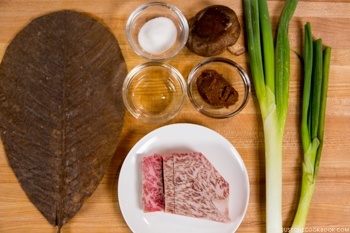
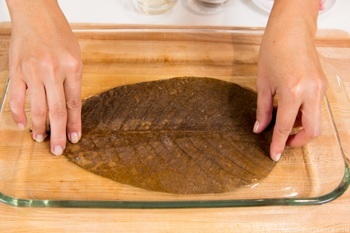
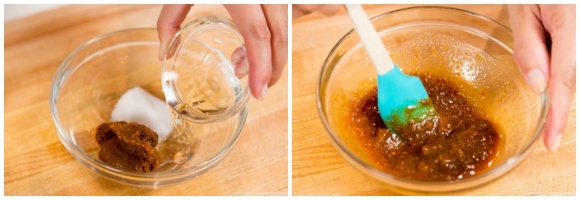
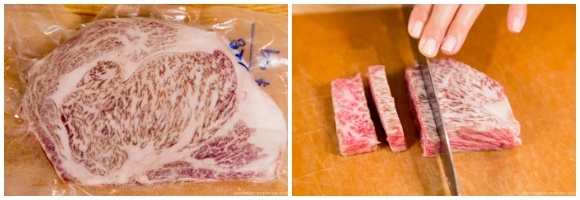
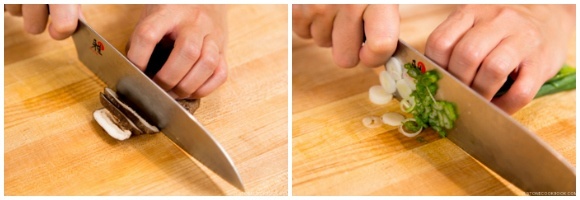
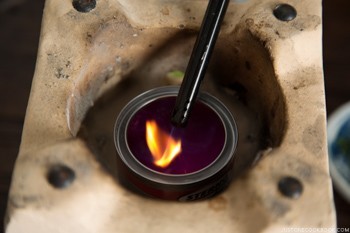
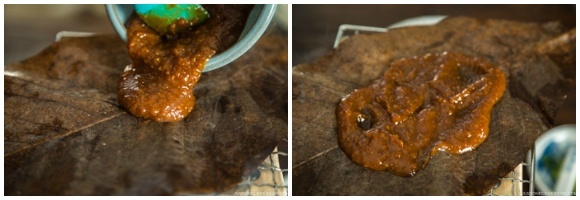
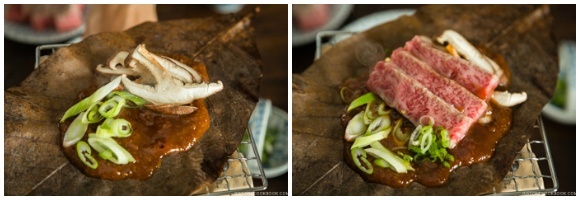
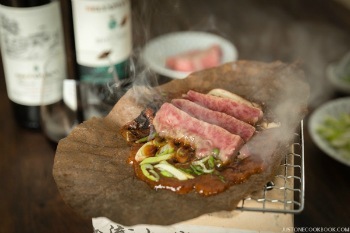











Hello Nami,
First, I want to thank you for doing a wonderful job running the website. I first came to this website as a senior in university learning how to cook for himself regularly after leaving the dorms, and the recipes here are a staple in my diet.
I am now studying in Berkeley, which is also in the Bay area (though a little far from San Jose), and looking for a new technique for beef to try, I thought this was interesting. However, I never saw Hoba leaves in the Japanese supermarkets I visited before. I noticed in the recipe pictures you used the actual leaves, I was wondering if in the Bay area Hoba leaves can be found in the Japanese supermarkets, or would I need to order them through Japanese Amazon?
Thank you
Hi Sidney! Thank you for your kind words! I haven’t seen hoba leaves in Japanese markets here or Amazon. I purchased them in Takayama and brought back to make this recipe. You can use aluminum foil to make this dish although there is no hoba fragrance… 🙁
Thanks for the reply!
I was searching through the comments and noticed you posted this link a while ago:
https://www.amazon.co.jp/%E5%B0%8F%E6%9E%97%E5%A4%9A%E7%94%B7%E5%95%86%E5%BA%97-%E6%9E%AF%E3%82%8C%E6%9C%B4%E8%91%89%E3%80%8010%E6%9E%9A/dp/B005TGB2NY/ref=sr_1_2?ie=UTF8&qid=1473195156&sr=8-2&keywords=%E3%81%BB%E3%81%86%E3%81%B0
If I made an account on Japanese amazon, would they be able to ship to USA? Or would I need to have access to things like a Japanese bank account/credit card?
Alternatively, seeing this recipe reminded me of how in Chinese restaurants you often see sticky rice steamed in lotus leaves like so: https://www.seriouseats.com/recipes/2015/03/sticky-rice-wrapped-lotus-leaf-lo-mai-gai-recipe.html
I wonder if the lotus leaf could be used as a substitute? I feel like it may be better than using Aluminum foil since you can can get some leaf fragrance, but there’s also the possibility that the lotus leaf flavor would make the overall taste very different from the original.
Looking forward to hearing your thoughts!
Hi Sidney! No, this won’t ship to the US. 🙁 It’s really a bummer… Lotus leaf is kind of different. Hoba leaves has a distinct flavor to it, which is different from a lotus leaf. 🙁
I see, that is a shame. Well, I suppose the next time I go to Japan, I’ll try to buy some Hoba leaves to bring home. The memories of Takayama people in the comments described sound amazing. The nice thing is that it doesn’t look far from other destinations like Kanazawa, so I am sure I will have a chance to visit some day.
Thank you for answering all of my questions. Also I wanted to say again, thank you and the team for making this website thorough and easy to use. I will continue being a loyal supporter for years to come.
Sweet memories! We had this in Takayama in October last year. We almost licked the leaf!
Would love to recreate this dish at home.
Hi Karen! Hahaha I know what you mean by licking the leaf. I might have done that too! 😀
[…] Takayama area so some of the dishes feature ingredients from the Hida area (such as Hida beef and hoba leaves). Most ryokans in Japan serve Kaiseki meals during dinner showcasing the local ingredients and […]
[…] kanazawa-experience, justonecookbook, muraisuisan, okayama.eng, yossense, […]
I was recently in Takayama and tried this dish and I LOVE it so much. The rice was so tasty as well I could not stop eating it. I actually bought some dried magnolia leaves in Takayama 🙂 I did notice that the leaves there are so much bigger than the usual leaves I see here.
Thank you for providing the recipe! I didn’t know I could add mirin to the miso. I actually tried to make the dish the other night, before I saw your recipe. I added a little rice vinegar to the miso paste(also bought in Takayama :)). It turned out to be quite good and did bring back sweet and tasty memory.
Thank you 🙂
Hi Echo! I’m so glad to hear you got to try this dish in Takayama and you bought the leaves too! You and I are alike. 😀 Enjoy making Hoba Miso at home! 🙂
[…] The Hida Beef with Hoba Miso Set 飛騨牛朴葉味噌定食 This seems to be the signature dish of the region and it’s oh so good. On a table stove called Hida Konro 飛騨こんろ, a dried magnolia leaf called Hoba 朴葉 is used as a base for your grill. Local Shirakawa-go miso paste, thin slices of Hida-gyu beef as well as mushrooms and spring onions are placed on the Hoba leaf. Once the mixture starts sizzling and amazing fats drip from the beef into the sauce. The result is an out of the world gastronomic experience! More on illmakeitmyself.net and justonecookbook.com. […]